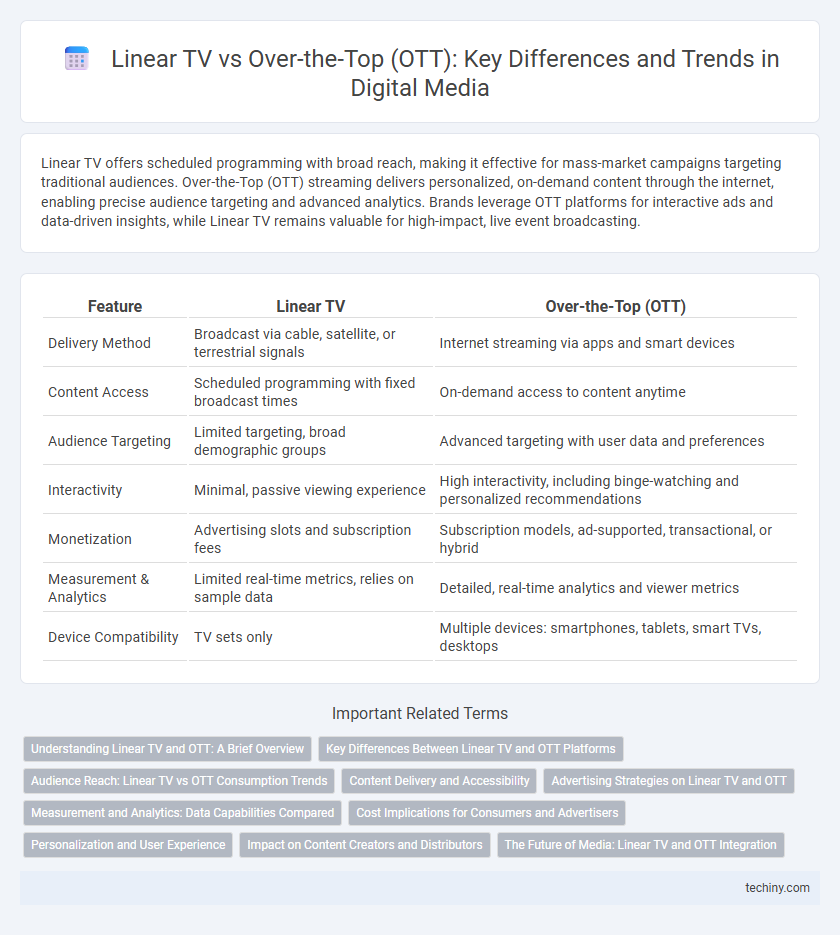Linear TV offers scheduled programming with broad reach, making it effective for mass-market campaigns targeting traditional audiences. Over-the-Top (OTT) streaming delivers personalized, on-demand content through the internet, enabling precise audience targeting and advanced analytics. Brands leverage OTT platforms for interactive ads and data-driven insights, while Linear TV remains valuable for high-impact, live event broadcasting.
Table of Comparison
| Feature | Linear TV | Over-the-Top (OTT) |
|---|---|---|
| Delivery Method | Broadcast via cable, satellite, or terrestrial signals | Internet streaming via apps and smart devices |
| Content Access | Scheduled programming with fixed broadcast times | On-demand access to content anytime |
| Audience Targeting | Limited targeting, broad demographic groups | Advanced targeting with user data and preferences |
| Interactivity | Minimal, passive viewing experience | High interactivity, including binge-watching and personalized recommendations |
| Monetization | Advertising slots and subscription fees | Subscription models, ad-supported, transactional, or hybrid |
| Measurement & Analytics | Limited real-time metrics, relies on sample data | Detailed, real-time analytics and viewer metrics |
| Device Compatibility | TV sets only | Multiple devices: smartphones, tablets, smart TVs, desktops |
Understanding Linear TV and OTT: A Brief Overview
Linear TV delivers scheduled content through traditional broadcast or cable networks, providing real-time programming with limited viewer control. Over-the-Top (OTT) platforms stream content via the internet, enabling on-demand access and personalized viewing experiences across multiple devices. The shift from Linear TV to OTT reflects changing consumer behaviors favoring flexibility, interactivity, and content variety.
Key Differences Between Linear TV and OTT Platforms
Linear TV delivers scheduled programming through traditional broadcast or cable networks, providing limited viewer control over content timing. OTT platforms stream content via the internet, offering on-demand access with personalized recommendations and multi-device compatibility. Unlike Linear TV's fixed advertising slots, OTT allows targeted advertising based on user data, enhancing engagement and measurement precision.
Audience Reach: Linear TV vs OTT Consumption Trends
Linear TV continues to deliver broad audience reach with millions of daily viewers, particularly among older demographics, while OTT platforms rapidly gain traction by attracting younger, tech-savvy users through on-demand content access. OTT consumption trends show a significant increase in streaming hours globally, driven by personalized viewing experiences and multi-device accessibility. Data from recent market analysis reveals that OTT usage is projected to surpass linear TV viewership within the next five years, emphasizing a shift in media consumption preferences.
Content Delivery and Accessibility
Linear TV delivers scheduled programming through traditional broadcast infrastructure, limiting viewer control and accessibility to specific regions. Over-the-Top (OTT) platforms utilize internet streaming, offering on-demand content accessible across multiple devices and locations globally. This shift enhances viewer flexibility and expands content availability beyond conventional broadcast constraints.
Advertising Strategies on Linear TV and OTT
Linear TV advertising relies on scheduled programming and broad audience targeting, utilizing traditional commercials to reach mass viewership during peak times for maximum exposure. Over-the-Top (OTT) advertising leverages data-driven insights and programmatic buying, enabling precise audience segmentation with personalized ads delivered through streaming platforms. OTT campaigns offer enhanced interactivity and measurable engagement metrics, optimizing ad spend and effectiveness compared to the fixed impressions of Linear TV.
Measurement and Analytics: Data Capabilities Compared
Linear TV measurement relies heavily on traditional Nielsen ratings and set-top box data, offering limited granularity and delayed reporting. OTT platforms provide real-time analytics with detailed viewer behavior tracking, including device usage, engagement metrics, and demographic segmentation. The advanced data capabilities of OTT enable more precise ad targeting and campaign optimization compared to the aggregated and less dynamic datasets from Linear TV.
Cost Implications for Consumers and Advertisers
Linear TV generally incurs higher costs for consumers due to subscription fees and bundled channel packages, limiting flexibility and leading to potential underutilization of paid content. OTT platforms offer cost-effective options by allowing viewers to pay only for selected content, reducing expenses and enhancing user control. Advertisers benefit from OTT's targeted ad delivery and measurable ROI, contrasting with Linear TV's broader reach but less precise audience segmentation and higher advertising expenditure.
Personalization and User Experience
Linear TV offers limited personalization options, restricting content delivery to scheduled programming with minimal user control. Over-the-Top (OTT) platforms leverage advanced algorithms to provide highly tailored viewing experiences based on individual preferences and viewing history. Enhanced user experience on OTT includes on-demand access, interactive features, and adaptive streaming quality for seamless consumption across multiple devices.
Impact on Content Creators and Distributors
Linear TV commands established audiences and predictable ad revenues, offering content creators stable exposure but limited flexibility in programming and monetization. Over-the-Top (OTT) platforms empower creators with direct access to global audiences, enabling diversified revenue streams through subscriptions, ads, and data-driven targeting. Distributors leverage OTT's advanced analytics for personalized content delivery, while linear TV relies on scheduled broadcasts, impacting the agility and scalability of content distribution strategies.
The Future of Media: Linear TV and OTT Integration
The future of media is shaped by the seamless integration of Linear TV and Over-the-Top (OTT) platforms, combining traditional scheduled programming with on-demand streaming capabilities. Advanced data analytics and personalized content delivery enhance viewer engagement, driving a hybrid ecosystem where advertisers gain precise targeting opportunities across both linear and digital channels. This convergence empowers networks to optimize content monetization while adapting to evolving consumer preferences in a competitive media landscape.
Linear TV vs Over-the-Top (OTT) Infographic

 techiny.com
techiny.com